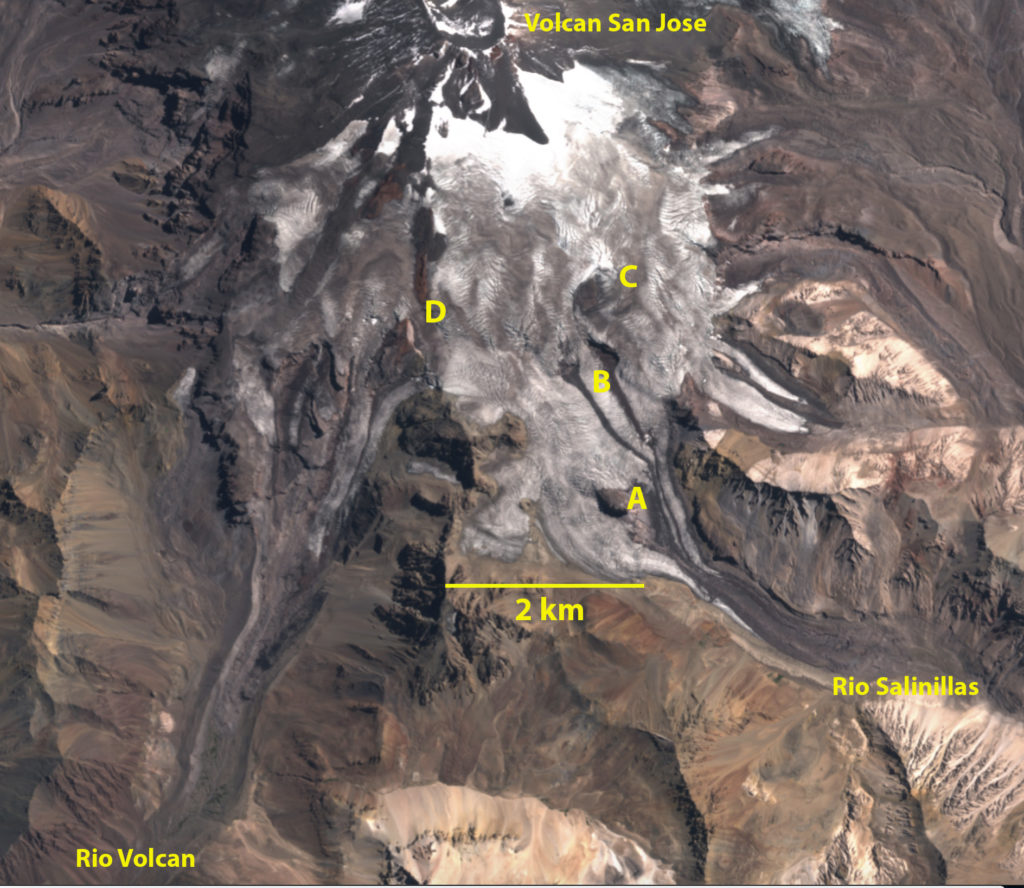March 4, 2022
Volcan San Jose, Central Andes Glacier Decline and Snowcover Loss in 2022.
Posted by Mauri Pelto
Volcan San Jose, Chile/Argentina Glacier change in Landsat 5-7-9 images from 1991, 2001 and 2022. Red arrows indicate the 1991 terminus location of three glaciers draining from the summit region, including Nieves Negras Glacier (NN). Point A-D are locations of expanding bedrock amidst the glacier. Snowpack very limited in 2022.
Volcan San Jose is a 5850 m glacier draped volcano that straddles the Argentina-Chile border. Here we focus on the glaciers on its souther flank including the Nieves Negras Glacier. Nieves Negras drains into Rio Volcan a tributary of Rio Maipo, while the Argentina terminating glaciers drain into Rio Salinillas. Ayala et al (2020) examined glacier change from 1955–2016 in the Rio Maipo Basin and found a decreasing glacier mass balance trend and that glacier volume decreased by 20%. Dussaillant et al (2019) identified slower mass loss -0.28 m/year in this region from 2000-2018, than further south in the Patagonia Andes or north in the Tropical Andes. Here we examine glacier changes from 1991 to 2022 with Landsat imagery and the low snowpack conditions of 2022 with Landsat and Sentinel images.
In 1991 Nieves Negras and the Rio Salinillas headwater glaciers terminated between 3100 and 3200 m. The snowline is at 4500 m, and there is insignificant bedrock exposed at Point B and C. By 2001 limited retreat had occurred, while bedrock exposure is apparent at Point B. The snowline is at 4600 m in 2001. In February of 2022, the glacier has retained less than 10% snowcover, with the snowline at 5200 m. The surface is notably dirty, which has enhanced melting during this summer. Bedrock area at Point A is now 0.25 km2. Bedrock exposed at Point B has now generated two medial moraines. The bedrock exposed at Point C now has an area of 0.1 km2. At Point D there is nearly continuous bedrock extending along the ridge that marks the International boundary and the east margin of Nieves Negras. Glacier retreat of Nieves Negras is 1.7 km, there is stagnant ice below the current terminus. The debris cover obscures the actual terminus of the glacier at the headwaters of Rio Salinillas. While the northern terminus location indicates a retreat of 900 m.
The lack of snowcover matches that seen in other glacier of the Central Andes in summer 2022 such as ate the runoff into the Rio Plomo Earlier observations indicate this is a regional issue this summer with snowpack lost from Bajo del Plomo Glacier, Cortaderal Glacier, Palomo Glacier, Volcan Overo Glacier and Olivares Beta and Gamma Glaciers across the Central Andes of Chile and Argentina
Volcan San Jose glaciers in Feb. 17, 2022 Sentinel image. This highlights just how dirty the ice surface is and how limited the retained snowcover is.




 Dean of Academic Affairs at Nichols College and Professor of Environmental Science at Nichols College in Massachusetts since 1989. Glaciologist directing the North Cascade Glacier Climate Project since 1984. This project monitors the mass balance and behavior of more glaciers than any other in North America.
Dean of Academic Affairs at Nichols College and Professor of Environmental Science at Nichols College in Massachusetts since 1989. Glaciologist directing the North Cascade Glacier Climate Project since 1984. This project monitors the mass balance and behavior of more glaciers than any other in North America.